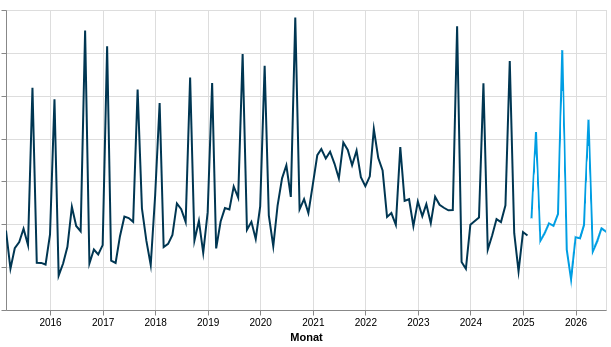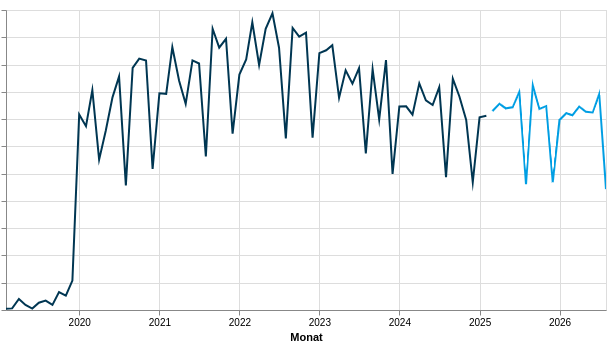Background: Sales planning and capacity planning are not always consistent
Julius Blum GmbH, an Austrian manufacturer of furniture fittings, distributes its products across a total of 100 markets. For production planning, the company must estimate required capacities for the upcoming 18 months. This process demands planning figures at a detailed level to provide insights into material requirements.
Due to the complexity of Blum’s products, this granular level comprises over 2.000.000 planning objects. An intermediate level, consisting of just over 100.000 planning objects, serves a key purpose: it allows characteristic patterns within individual segments to be incorporated into the forecast, despite the sometimes short and irregular demand for each individual planning object.
On the one hand, Blum used data-driven and automated forecasts to establish consistency in its planning figures across various hierarchical levels. The goal was to generate coherent numbers throughout the supply chain, from manufacturing materials to the final, sellable product. On the other hand, the company wanted its planners to navigate the sheer volume of planning objects effectively. This is achieved by creating a clear focus within the forecasts for these objects, highlighting the most critical items.
“A key point for our sales team is the qualification of the forecast. If we manage to significantly reduce the workload of the salespeople through our development, that would be a remarkable success and the automated forecasts would have a secure place in sales planning.”
Goals and requirements
- Improve forecast accuracy for monthly forecasts with a planning horizon of up to 18 months
- Take special cases into account and treat them appropriately, especially discontinued items
- Hierarchical forecasting at selected hierarchical levels to ensure consistency – since no single level was able to cover the planning requirements on its own
- Efficiently guide planners to the critical cases to save them time
Approach: an individual forecasting solution through agile development

From the very beginning, we designed the development of the forecasting solution for Blum as a dynamic and agile process to enable flexibility and continuous adaptation to our customer’s needs. In close collaboration with Blum, supported by sketches and concrete examples, we iteratively refined our understanding of the specific requirements. Building on this, we started early with experiments and prototyping. We examined forecast accuracy at various hierarchy levels, developed approaches for classifying planning objects, and identified special patterns such as discontinued items or marketing effects.
The core of our approach was a continuous cycle: we generated initial results, discussed them intensively with the users, and immediately adapted the solution based on Blum’s valuable feedback. In this way, the prototype was gradually optimized and developed into the best forecasting strategy. This ultimately led to a stable implementation that also included fallback methods and flexible data import and export. In parallel with development, we documented the solution, handed it over to Blum, and trained the employees. Even after the initial commissioning, we continued to live the agile concept: with a growing user base and new feedback, the solution underwent further improvement cycles to continuously increase its benefit.
Components of the solution
- Forecasting functionalities on multiple hierarchy levels incl. (dis)aggregation logic and reconciliation calculations
- Traffic-light system with retrospective traffic light: categorization of forecasts based on historical performance + clear presentation
- Plausibility check for the forecasts
“The quality of the forecasts has convinced us to regularly import them into SAP IBP as the baseline forecast for our rolling sales planning.”

Result: 10 % better forecast accuracy
Blum feeds the results generated by the forecasting solution straight into SAP IBP so that they can be used immediately. With the solution they achieved a 10% improvement in forecasts at the highest aggregated level compared with SAP IBP. A novel traffic-light system gives users an overview of product categories and markets that require attention or where the automated forecast can be trusted, which saves a considerable amount of time. Consistency of forecasts across the various hierarchy levels is also ensured. The positive feedback from the key users confirmed this, as they wanted to use the forecast as the basis for planning in the very next planning cycle.
The individual forecasting solution consists of a Python package that provides the agreed functionality and customer-specific scripts that automatically launch the overall program, tailored to the customer’s infrastructure. The latter were created in cooperation with the customer’s data scientists/engineers to integrate seamlessly into the existing infrastructure.
“We want to be able to maintain and further develop the solution ourselves. prognostica has documented it accordingly and trained us in its use.”
The project team
Christian
Senior Data Scientist(prognostica GmbH)

German Wehinger
Senior Project Manager(Julius Blum GmbH)

Jessica Costa da Rocha
Data Scientist(Julius Blum GmbH)

Joshua Beal
Data Scientist(Julius Blum GmbH)

Stefan Kolhaupt
Process Owner for Sales Planning and Steering Processes (Julius Blum GmbH)

Pascal Röck
Process Owner for Sales Planning and Steering Processes (Julius Blum GmbH)

Alexander Kolb
IT Solution Architect(Julius Blum GmbH)

Would you also like to improve your planning figures while at the same time reducing manual effort? Then
and we will arrange an initial online appointment.